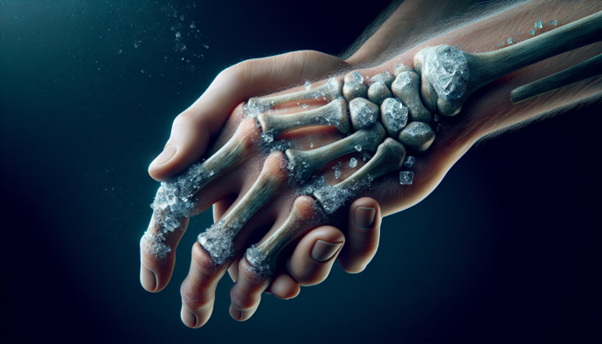Navigating the complexities of pseudogout, a condition often mistaken for its counterpart, gout, involves understanding its nuanced symptoms, causes, and treatment options. Unlike gout, which is caused by uric acid crystal deposition, pseudogout is characterized by the formation of calcium pyrophosphate crystals in the joints, leading to painful episodes of inflammation. This condition, also known as calcium pyrophosphate deposition disease (CPPD) or chondrocalcinosis, can manifest in various joints but often targets the knee. Recognizing the significance of distinguishing between pseudogout and gout lies not only in the symptomatic relief of the patient but also in the prevention of potential long-term joint damage. With advancements in medical imaging techniques such as ultrasound, dual-energy CT and MRI scans, and comprehensive laboratory tests, accurately diagnosing pseudogout has become more efficient, highlighting the importance of professional consultation with a rheumatologist.
The article delves into the aetiology of pseudogout, outlining primary causes, including hemochromatosis and hyperparathyroidism, and the role of inflammation in exacerbating joint discomfort. Symptoms, often mirroring those of osteoarthritis, include acute pain, swelling, and reduced joint mobility, leading to a significant impact on quality of life. Diagnostic methods such as joint aspiration, which involves the extraction and analysis of synovial fluid, play a pivotal role in identifying the presence of calcium pyrophosphate crystals. Treatment strategies encompass a range of options, from non-steroidal anti-inflammatory drugs (NSAIDs) and colchicine to corticosteroids and interleukin beta-1 antagonists aimed at managing pain and reducing inflammation. Moreover, preventive measures and lifestyle modifications, including dietary adjustments to mitigate triggers and the potential utility of magnesium supplements, are explored to offer a holistic approach to managing pseudogout. Through a comprehensive overview of diagnosis, treatment options, and prevention strategies, this guide endeavours to equip individuals with the knowledge to tackle pseudogout effectively and improve overall joint health.
What is Pseudogout?
Definition and Overview
Pseudogout, formally known as calcium pyrophosphate deposition disease (CPPD), is a type of arthritis characterized by the accumulation of calcium pyrophosphate dihydrate (CPP) crystals in the joints [1]. Unlike gout, which results from uric acid crystals, pseudogout is caused by these distinct CPP crystals [2]. This condition primarily affects larger joints like the knees, though wrists and ankles can also be involved [3]. It tends to occur more frequently in older individuals and affects men and women equally [2].
Differences between Gout and Pseudogout
While both pseudogout and gout involve crystal deposition in the joints leading to painful inflammation, the types of crystals and their effects differ significantly. Gout is caused by the deposition of monosodium urate crystals, often due to high uric acid levels in the blood, and typically targets the big toe [2]. In contrast, pseudogout is triggered by CPP crystals and does not correlate with dietary factors, unlike gout, which can be exacerbated by consumption of red meat and certain types of alcohol [2].
Diagnostically, gout and pseudogout can be differentiated through joint fluid analysis under a polarized microscope. Gout crystals appear needle-shaped and negatively birefringent, whereas pseudogout crystals are rhomboid-shaped and positively birefringent [2]. Additionally, pseudogout is not influenced by body temperature and does not have specific triggers that lead to flare-ups, setting it further apart from gout [1].
Causes of Pseudogout
Genetic Factors
Pseudogout has a notable genetic component, with certain mutations in the ANKH gene increasing susceptibility to the disease. These genetic variations can lead to earlier onset and more severe symptoms, particularly affecting the spine and causing CPPD-related back pain. Although the ANKH gene mutation is rare, it represents a significant risk factor for developing pseudogout [4].
Health Conditions
Multiple health conditions are linked to an increased risk of pseudogout. These include metabolic and endocrine disorders such as hemochromatosis, which leads to excessive iron accumulation in the body, and hyperparathyroidism, which results in abnormal calcium levels in the blood [4]. Hypomagnesemia, characterized by low magnesium levels, and hypophosphatasia, affecting bones and teeth, also predispose individuals to pseudogout. Chronic kidney disease, particularly in its advanced stages, has been associated with secondary hyperparathyroidism and subsequently with pseudogout [5].
Age and Other Risk Factors
The likelihood of developing pseudogout increases significantly with age. Research indicates that the risk doubles with each passing decade after the age of 60 [4]. Besides age, other factors such as a history of osteoarthritis and the use of loop diuretics have been identified as contributors to the risk of developing pseudogout. These factors highlight the complex interplay of age-related changes and specific health conditions in the pathogenesis of pseudogout [5].
Symptoms of Pseudogout
Common Symptoms
Pseudogout manifests through a variety of symptoms, primarily affecting large joints such as the knees, wrists, and ankles. Individuals may experience sudden, intense joint pain accompanied by skin discoloration or redness, swelling, and stiffness [3,6]. A notable warmth or heat sensation around the affected joint is also common, signaling inflammation. These symptoms can appear abruptly and may last from a few days to several weeks, often resembling flares or attacks [6]. In some cases, pseudogout may present as chronic, causing continuous pain and discomfort, which can be mistaken for conditions like osteoarthritis or rheumatoid arthritis [3].
How to Differentiate from Other Conditions
Differentiating pseudogout from similar conditions such as gout, osteoarthritis, or rheumatoid arthritis involves specific diagnostic approaches. A key method is joint aspiration, where fluid is drawn from the affected joint and analyzed under a microscope. The crystals responsible for pseudogout, calcium pyrophosphate dihydrate (CPPD), are rhomboid-shaped and positively birefringent, contrasting with the needle-shaped and negatively birefringent crystals seen in gout [2,7]. X-rays can also be beneficial, revealing crystal buildup or signs of joint damage unique to pseudogout, such as calcifications in the soft tissues around the joints, which are not typical of gout [2]. These diagnostic tools are crucial for accurate identification and appropriate management of the condition.
Diagnosis of Pseudogout
Medical History and Physical Examination
To initiate the diagnosis of pseudogout, healthcare providers conduct a thorough medical history review and physical examination. They inquire about the onset, pattern of symptoms, and family medical history to differentiate pseudogout from similar conditions such as septic arthritis [8]. During the physical examination, doctors assess the affected joints for swelling, pain points, and range of motion. This comprehensive evaluation helps to identify symptoms that are characteristic of pseudogout, such as sudden and intense joint pain [8,9].
Testing Methods
The definitive method for diagnosing pseudogout is joint fluid analysis via arthrocentesis. During this procedure, a needle is used to withdraw synovial fluid from the affected joint. The extracted fluid is then analyzed under a polarized microscope to detect the presence of calcium pyrophosphate (CPP) crystals, which are indicative of pseudogout [8,9,10].
X-rays and other imaging techniques like CT scans and ultrasounds are also employed to observe chondrocalcinosis, which appears as calcification in the cartilage and supports the diagnosis of pseudogout [8,10,6]. In some cases, MRI may be used to evaluate the extent of calcium pyrophosphate crystal deposition in joint cartilage, providing further diagnostic clarity [10].
These diagnostic tools are crucial for confirming pseudogout and ruling out other potential conditions, ensuring that patients receive the appropriate management for their symptoms.
Treatment Options
Medications
For those experiencing pseudogout, a range of medications is available to manage pain and inflammation. Nonsteroidal anti-inflammatory drugs (NSAIDs), both over-the-counter such as ibuprofen and prescription strength like naproxen and indomethacin, are commonly prescribed [11,12,13]. Colchicine, used in low doses, can be effective for managing frequent pseudogout episodes and may be prescribed for daily use to prevent flare-ups [11,13]. In cases where NSAIDs or colchicine are unsuitable, corticosteroids such as prednisone may be recommended to reduce inflammation and alleviate symptoms [11,13]. Additionally, for severe cases, healthcare providers may suggest interleukin-1β inhibitors or other biologics, although these are generally more costly [14,6].
Non-pharmacological Treatments
Joint aspiration is a procedure often used to relieve pressure and pain in the affected joint by removing fluid and crystals [11,14]. This may be combined with corticosteroid injections to decrease inflammation [14,3]. Physical therapies, including the application of heat or ice and restricted movement of the affected joint, are advised to support recovery and ease discomfort [15,14].
Lifestyle and Home Remedies
Managing pseudogout also involves several home remedies and lifestyle adjustments. Resting the impacted joint and applying ice packs can significantly reduce inflammation and pain [11,13]. Elevating the affected limb might also help in reducing swelling [14]. Dietary considerations play a minor role in managing pseudogout compared to gout, but maintaining a balanced diet rich in anti-inflammatory foods such as fruits, fish, and nuts can support overall joint health [13]. Regular physical activity, tailored to the individual’s capacity, helps maintain joint function and muscle strength, which are crucial for those with joint diseases [15].
Prevention and Management
Diet and Nutrition
Managing pseudogout involves dietary considerations to help control flare-ups and maintain overall joint health. While diet does not directly influence the formation of calcium pyrophosphate crystals, it plays a crucial role in managing inflammation and overall health. It is advisable to avoid high-purine foods such as red meat and shellfish, which are more commonly associated with gout but can also affect inflammation levels in pseudogout [16,17]. Incorporating anti-inflammatory foods like cherries, berries, fatty fish rich in omega-3 fatty acids, and nuts can be beneficial. These foods help combat inflammation and support joint health [17,13].
Exercise and Physical Therapy
Physical therapy is integral to managing pseudogout, focusing on relieving pain, reducing swelling, and maintaining or improving joint mobility [18,19]. Therapists may employ techniques such as heat, ice, ultrasound, and gentle stretching to enhance joint function and alleviate discomfort [18,19,20]. Regular exercise, particularly low-impact activities such as walking, cycling, and aquatic exercises, is recommended. These activities reduce stress on the joints while maintaining strength and flexibility [20]. During flare-ups, gentle range-of-motion exercises help keep joints functional without exacerbating symptoms [18,20].
Monitoring and Follow-Ups
Regular monitoring and follow-ups with healthcare professionals are crucial for effectively managing pseudogout. This includes routine assessments of joint health and mobility, as well as keeping track of any new symptoms or changes in existing symptoms. For individuals with recurrent episodes, low-dose colchicine may be prescribed to prevent future attacks [10]. Additionally, managing associated health conditions such as hyperparathyroidism or hemochromatosis is vital, as these can influence the severity and frequency of pseudogout episodes [1310]. Regular consultations with a rheumatologist and adherence to a tailored treatment plan play a pivotal role in preventing exacerbations and managing the condition long-term.
Which items are known to worsen gout symptoms?
Conclusion
Throughout this guide, we have navigated the intricacies of pseudogout, illuminating its causes, symptoms, and the array of available treatments. By distinguishing pseudogout from gout and other similar conditions, we’ve emphasized the importance of accurate diagnosis and the pivotal role of comprehensive care, including medication, lifestyle modifications, and possibly, intervention through physical therapy. These efforts converge to not only manage the acute and chronic manifestations of pseudogout but also to preserve joint health and maintain quality of life.
As we conclude, it’s imperative to acknowledge the significance of ongoing management and monitoring for individuals living with pseudogout. Advocating for a proactive approach—be it through regular medical consultations, adherence to prescribed treatments, or engagement in physical activities tailored to one’s abilities—underscores the path towards mitigating the impact of this condition. Equipped with this knowledge, individuals and caregivers alike are better prepared to tackle pseudogout, fostering an environment where informed decisions pave the way for improved health outcomes.
FAQs
What causes pseudogout?
Pseudogout is primarily caused by the accumulation of calcium pyrophosphate dihydrate crystals in the joints. This condition is more common as individuals age, with nearly half of those over 85 experiencing crystal deposits. However, not everyone with these deposits will develop pseudogout.
What are the most effective treatments for pseudogout?
The best treatments for pseudogout include nonsteroidal anti-inflammatory drugs (NSAIDs) such as naproxen (Naprosyn) and indomethacin (Indocin), low-dose colchicine (Colcrys, Mitigare), and corticosteroids. These medications help manage pain and inflammation associated with pseudogout.
Can certain foods trigger pseudogout?
Unlike gout, the consumption of specific foods or alcohol does not typically trigger pseudogout attacks. However, these factors can provoke gout flares, highlighting a significant difference between the two conditions.
What is a typical treatment plan for pseudogout?
For severe pseudogout attacks, doctors may prescribe prescription-strength NSAIDs like indomethacin. If NSAIDs are unsuitable, colchicine may be used to alleviate pain and swelling. This approach helps manage the symptoms effectively.
References
- https://www.medicalnewstoday.com/articles/pseudogout-vs-gout
- https://www.assh.org/handcare/blog/what-is-the-difference-between-gout-and-pseudogout
- https://familydoctor.org/condition/pseudogout/
- https://www.arthritis-health.com/types/pseudogout-cppd/pseudogout-causes
- https://www.ncbi.nlm.nih.gov/pmc/articles/PMC3475980/
- https://my.clevelandclinic.org/health/diseases/pseudogout-chondrocalcinosis-cppd
- https://www.arthritis.org/diseases/more-about/gout-or-pseudogout
- https://www.arthritis-health.com/types/pseudogout-cppd/pseudogout-diagnosis
- https://www.assh.org/handcare/condition/pseudogout
- https://www.ncbi.nlm.nih.gov/books/NBK540151/
- https://www.mayoclinic.org/diseases-conditions/pseudogout/diagnosis-treatment/drc-20376988
- https://www.treatingpain.com/news-updates/2021/september/pseudogout-understanding-your-prognosis-and-chan/
- https://www.medicalnewstoday.com/articles/pseudogout
- https://www.arthritis-health.com/types/pseudogout-cppd/pseudogout-treatment
- https://www.ncbi.nlm.nih.gov/pmc/articles/PMC6240445/
- https://emedicine.medscape.com/article/329958-treatment
- https://www.advancedsportsandspine.com/12-best-foods-to-ease-arthritis-and-other-joint-pain/
- https://capitolptdc.com/physical-therapy-for-pseudogout/
- https://fiziologix.com/blog-fiziologix-physical-therapy-tips-and-self-healing/8/13/2023/how-does-physical-therapy-helps-manage-pseudogout
- https://orthop.washington.edu/patient-care/articles/arthritis/cppd-deposition-disease.html






